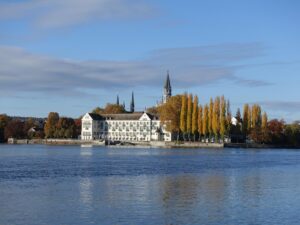
Genevan exiles at Lake Constance
In November 1834, 17-year-old Amélie Macaire, the daughter of a Genevan manufacturer, married German Count Friedrich von Zeppelin on an island in Constance that was the site of a former monastery. French was the predominant language spoken. And not without reason...


‘The Genevans’

The Macaire de L’Or family


Carl von Häberlin and Switzerland
Born in Oberesslingen near Stuttgart in 1832, Carl von Häberlin was undoubtedly the most important and productive exponent of late-period history painting in a naturalistic vein in southwestern Germany. His monumental cycle of paintings depicting the history of the former monastery island in Constance is one of the most spectacular, and probably also one of the most visited, oeuvres of its kind. While working on-and-off on the paintings in the Inselhotel from 1887 to 1896, he set up private residence in Schloss Wyden near Ossingen, an area in the canton of Zurich known for its wine. His attention had been drawn to the castle by fellow countryman Julius Motteler, who had organised the first Congress of the German Social Democratic Party there in 1880 while living in exile in Zurich, at a time when the party was banned under Bismarck’s Anti-Socialist Laws.
During his stay at Wyden, he also created the murals at Schloss Castell in Tägerwilen (Thurgau) and in the town hall of Stein am Rhein (Schaffhausen), for which he was made an honorary citizen on 25 March 1901, thereby also gaining Swiss citizenship. He also prepared three sketches for the competition to design the murals for the Hall of Arms in the Swiss National Museum in Zurich during the period of its construction from 1893 to 1898. However, the commission was awarded to Ferdinand Hodler, an artist whose completely new style of history painting was both highly expressive and highly unconventional, leading to the longest and most passionately contested quarrel over art Switzerland had ever seen.





